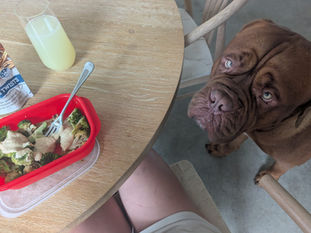
How to read your dog’s body language - the hips, lips and licks don’t lie
0
12
0
Dogs don’t lie. They’re present, honest and will always give you clues, signs and signals about how they feel. We just have to slow down enough to pay attention.
The primary form of communication (even though some of you may feel it’s barking!) is body language. Dogs rely on their physicality to express themselves, with each other, and with us.
So let’s go over some of the basics, that you’re probably all over, and then some of the more nuanced signals that could come in really handy.
What does a chill pup look like?
Start with your furry mate's face. Is the mouth ever so slightly open? Eyes relaxed, with lids that aren’t peeled back? Perhaps your dog smiles and the curve is there at the lips? That’s a great place to start. Then, check your dog’s body. How are they sitting or laying? Sprawled, splayed or sitting with a soft, curved spine? Good-o! If that tail is a-wagging on top of all this - slow and languid, or gentle and tappy, that a happy K-9!
Now let’s look at a dog that is ready to go. Heightened, perhaps about to go for a W-A-L-K or greeting a new person entering the home. Is your dog’s tail going quickly, pointed up or out? How about paw position? Is their body leaning forward, shoulders squared? If your dog’s got heckles,are they standing to attention? This indicated readiness, excitement, arousal. Eyes are wider, focused or moving quickly. If their ears are also up, you know your dog is alert and very present.
Cautious, anxious or concerned could look like yawning, lip licking or side eye. They might be looking back at you, checking in about this new situation or person. Their ears might be adjusting, moving back and forward as they try to assess the environment. Add in some body language of moving around, pacing or avoiding the other dog, or person and your dog is on high alert - and not feeling confident. You will see this as not wanting to ‘say hello’ or ‘being shy’. Try to respect your dog - never make them ‘meet’ someone when they are showing these signs. Believe them in their discomfort and simply move away.
Another great time to really advocate for your furry friend is when they show signs of being fearful. This could take many forms, like rolling over when approached to show submission, or a tense grin that is meant to diffuse a situation with a more dominant dog or person they feel uncomfortable around. They’ll avoid eye contact, make themselves small or may simply look away as a show of discomfort and appeasement. Pay attention in these times and be ready to help your dog move away or, if in a safe environment, help teach your mate that they have nothing to fear.
Defensive feelings in a dog can look like: teeth bared, ears forward, locked and starting intently. Shoulders are square, they might growl. Or they are standing on tip toe, pulling toward the scary thing. This means your dog is on guard, and ready to act if they feel threatened. Distraction is key here, and for example, if your dog is on lead and another approaching, get those delicious treats ready, move your dog away with one cue ‘’come” and place your body between them. Ask the other dog’s caretaker to leash or recall their dog and diffuse the situation by advocating for your dog. Help them feel safe.
Perhaps this also looks like two off leash dogs meeting, and yours goes all slow motion, stiff, but tail up and wagging. While the other dog leaps around, tongue lolling and being exuberant, your dog is thinking ‘hell naw’ and has held its position, moving like it’s doing the robot. This also shows the other dog your dog is not up to play, feels uncomfortable and it needs to have its space respected.
Things you might think mean nothing, but mean a lot in the dog world.
Scratching - this is a displacement action, showing the other dogs (and you!) that it’s not too sure how to handle the situation
Moving from one position to another - mixed physical messages show us that your dog is really not comfortable. You dog might be sitting, then boom standing, then boom walking behind you. Not a comfy pup.
Ears akimbo - unless you have a dog that naturally has a floppy ear at all times (so cute) rapid ear movement means your dog is assessing and reassessing the situation. It’s on alert.
Random sniffing or self or other things - this means your dog is trying to disappear. Nope, nothing to see here, I don’t know what else to do, so I’ll distract myself with myself, or this interesting looking item….over here
One fast, quick face lick - or maybe just a couple, maybe even one lick. This is appeasement. If a dog does this to a child, with body language that is not inviting, eyes wide or looking away, and the dog does not move forward with a happy helicopter tail to engage - MOVE AWAY. This is a polite dog saying please leave my personal space. This is not cute, and could be a precursor to a bite, snarl or defensive move. It’s up to you to pay close, close attention to dogs and not allow children near their faces, or bodies unless they show you the clear and simple ‘yes’. A dog that is not moving has frozen to show unwillingness. That’s a no
Tail wagging - can mean so many things. Pointing up - alert. Helicopter - love. Low and slow - uncertain. Fast and up - potentially uncomfortable. Tucked - scared. Get to know your dog and once you start watching each type of tail movement, you will certainly better know how to work with your dog’s feelings.
There are some great courses to learn more about dog behaviour and psychology in our area. Check these out.
Delta Training Institute - the GOAT of dog learnings - https://www.deltainstitute.edu.au/
TAFE - some courses are free - https://www.tafecourses.com.au/course-listing/dog-psychology-behaviour-training-certificate-the-career-academy/?gad_source=1&gclid=CjwKCAiAqrG9BhAVEiwAaPu5ztxv9Z2WKRwWwvs26huvmNBvDfX5_tRn0hqHce7pOsCgA488dL9EZBoCAhkQAvD_BwE
Sit Stay Bondi - where Bo did his Puppy School - https://www.sitstay.com.au/
Online Courses - https://www.onlinecoursesaustralia.edu.au/online-courses/dog-grooming-pet-care-dog-training/dog-psychology-behaviour-training/
Or find a local, highly educated, compassionate trainer like https://www.icdogtraining.com.au/
Let us know if you'd like to chat more about your dog's behaviours or want to decipher
their body language - it's fascinating and will surely help build trust and a more peaceful life together.






